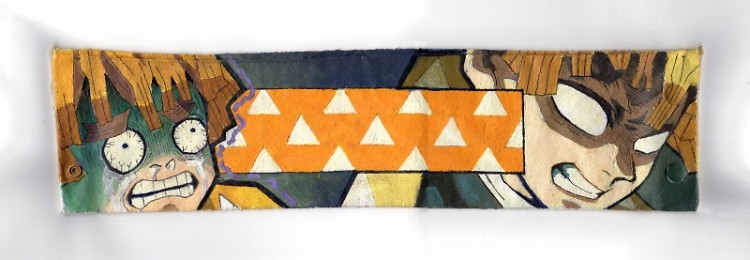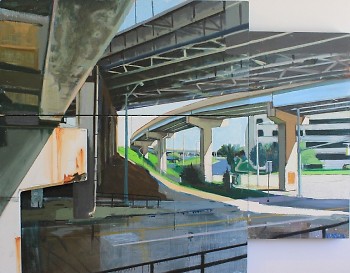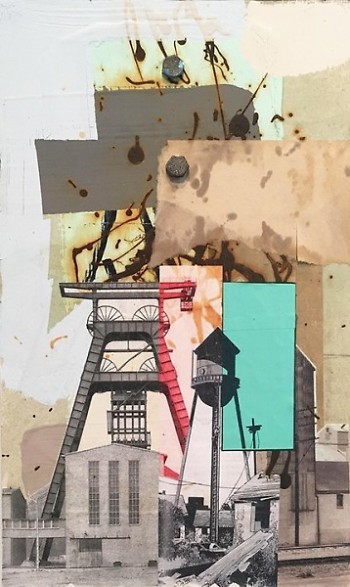Created to provide greater access to public art, Flex Gallery is a wearable, rotating exhibition space located on curator Zachary Trebellas' left arm. The mobile art space has to date hosted twenty-five custom armbands created by local, regional, and international artists that were exhibited in runs of two weeks each. Flex Gallery is curated with no limitations other than the dimensions of the canvas armbands which Trebellas supplies to each artist.
To commemorate the recent end of its fifth season, I’ve interviewed three of this year’s artists about their creative practices. Here are the responses of Indianapolis artist and owner of Spiral Gallery, a South Division mainstay from 2013–2018, Steven Vinson.
Zachary Trebellas (ZT): When did you start incorporating comic book and animé imagery into your work?
Steven Vinson (SV): Five or six years ago. I started with graphic novels and lately I’ve been looking at animé and manga as sources. Manga has a graphic quality that is so much more expressive than American graphic novels that I’ve come across. The mark making is much more fluid and interesting to look at.
[In planning out this armband] I rewatched the whole Demon Slayer series and every time Zenitsu was on there, I would pause it. If I saw a really strong face, a really pathetic face, I would pause, jot down a note of where it was, and once I went through all of them, I picked the two that I thought were a good compliment to each other.
ZT: Artists’ processes very wildly, so how does a piece start for you? What’s the first kernel of the piece and where do you go from there?
SV: That’s changed over the years. In the last few, my comfort with working with [Adobe] Illustrator has allowed me to digitally mock up what I want pieces to look like. Which I felt was especially important with something wearable [like this armband] and something that changed its shape depending on if it’s clasped or open. So, to figure that out I had it laid out in illustrator: the orange in the middle and the two images that I cropped out of the animé series directly from Netflix. I loosely plugged them in where I wanted them to be, and I started a sketch from there. Then I went along and made a few adjustments here and there, kept a few things more loose, especially with the paint in this hair and some of the background...Then I moved into laying it out on the actual armband from there.
It’s is pretty consistent with how I’ve been doing work for the past few years: using Illustrator to mock up the scale, etc. I wasn’t too familiar with [the program] in grad school, so I didn’t use it to mock up the larger urban landscapes I was doing.
ZT: When you were working with urban landscapes in Grand Rapids, were you photographing those first?
SV: I would take pictures and sketch. A lot of the landscapes I chose in Grand Rapids were nearby places I was going past a lot, so I would try to notice what the light was like that day, where the shadows were. Sometimes when I went past a space, a certain shadow or the lighting would be a little stronger, and I would try to take pieces of that. That’s why a lot of time [in my pieces] the sky will look like it’s in different sections of blue. The buildings will have sunlight hitting them in two different colors. I try to color block them based on memory. But I try to have photos to know the actual shapes and proportions are right. The color is based on repeated experiences in the space.
ZT: Where do you see your work moving forward from its current state?
SV: Right now the idea that I’m playing around with most is these cardboard pieces. They’re still going to be landscapes but smaller. They’re probably 4”x 8” and are going to have relief to them. I’m going to try to cut cardboard to match structures and trees. Then I’ll probably integrate pinned wires and electrical lines that cut across the front of the piece. They’ll be simple, and for now they’ll be scenes from the eastside of Indianapolis that I’ve been passing and seeing. Noticing what light has been hitting them, figuring out what kind of day is best to get images of them. A bit of a return to the urban landscapes I did in Grand Rapids, but a lot smaller.
ZT: What are some moments that you treasure from your experience running Spiral Gallery on South Division?
SV: A lot of my interactions with the locals. The random bizarre stories that happened. My ArtPrize show, getting on the best venue shortlist. I really liked the show that Le'Andra LeSeur did, her one-woman show at Spiral. That one was really really good, which I’m not surprised about because she’s phenomenal. I think I counted thirty-five or forty people that came in [for the opening], so not even a lot of people in the city saw it. Which I kind of like because it became a little more exclusive. It’s like, “Were you here for that? Did you see that?”
ZT: I think it was incredible that you were the only one to show her performance work, and then she went on to win ArtPrize the next year.
SV: She was a part of the ArtPrize show at Kendall College a few years before that, though just video work of performances she had done. So it was pretty dope that she trusted me enough to perform at Spiral.
And then, I had shows that were working with the community. I did a show with the Pride Center, an all trans show. I did a show with Robin Deerfield and Salvador Jimenez that was ceramic tiles that mentally impaired people in Grand Rapids had put together. Those were really nice.
It was fun, but it was also sad seeing less and less people show up. I don’t know what to attribute that to because the people that really wanted to see the art, they would go see it, but that crowd dwindled year after year. I don’t really know why.
You just have to set aside the time to go and do it. You don’t build a community by going three times a year to an art show. People always want to talk about community, especially in Grand Rapids it seems, but a community can’t just be a select group of fifty people that are making all the choices. The community is everybody working together, but people weren’t coming out consistently to build that community. I tried my best to have Spiral open every First Friday. I tried really hard to be consistent and have the doors open.
ZT: When I think about a sense of community, all it takes is people caring and putting in the effort, and it’s not always that much effort. You want this kind of vibrancy? Well, ok, show up. I don’t think it’s that hard at the end of the day.
SV: And you have to cultivate that environment so that the next generation of gallery viewers finds that exciting. You can’t just think, “Oh we love it. We’re not going to try to get other people to love it.” Because then when you stop going, nobody’s there. You’ve got to try to get other people enticed to go.
Ultimately it comes down to people having a desire to meet up. I get that all the people that were coming out to First Friday when I was having all those shows, now they’re married or have kids, etc. It gets hard to go out, but at the same time those people could be advocating. Once you’ve stopped doing the things that you really loved, you’ve got to be able to advocate for it. I would assume that everyone wants their interests to continue to the next generation, and the way that that happens is advocating to the next generation. You can’t expect them to just come across it on their own. There shouldn’t be just three people in the city doing that. It has to be a team effort.
I saw it when I first moved onto the Avenue. We’d have these meetings and there’d be forty people at them at Pub 43. They would stack six or seven tables next to each other, this long Last Supper style table. And you would see people again and again. People from Grand Valley, Kendall, Calvin, Aquinas, older people from the community, new people. One of the last ones I went to, there were just eight people at it. I don’t know where everyone went.
You can learn more about Steven Vinson and his work at his website. Furthermore, you can check out the history of Spiral Gallery on its Facebook page.
Flex Gallery was exhibited at the UICA in summer of 2017 and has been featured in Hyperallergic and Temporary Art Review. Its sixth season will run from January through April 2022.
The Rapidian, a program of the 501(c)3 nonprofit Community Media Center, relies on the community’s support to help cover the cost of training reporters and publishing content.
We need your help.
If each of our readers and content creators who values this community platform help support its creation and maintenance, The Rapidian can continue to educate and facilitate a conversation around issues for years to come.
Please support The Rapidian and make a contribution today.


